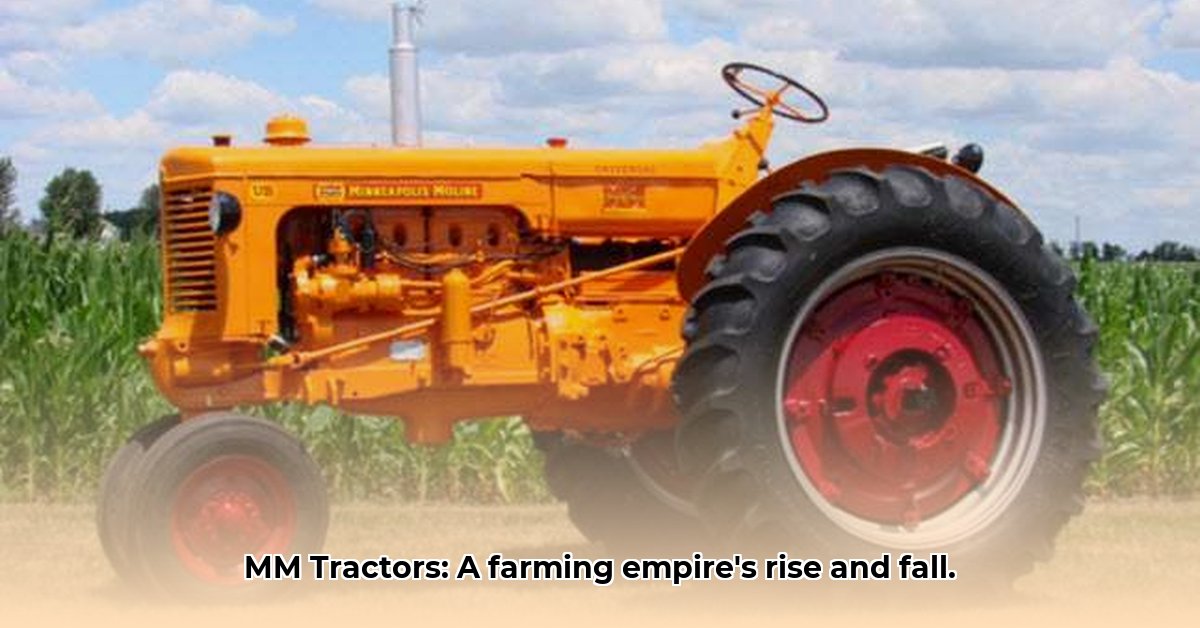
A Story Written in Steel and Soil: The Minneapolis-Moline Saga
The year is 1929. The Great Depression casts a long shadow over the American economy. Yet, amidst the uncertainty, two titans of the farm equipment industry, Minneapolis Steel & Machinery and the Moline Plow Company, merge, forming Minneapolis-Moline (M-M). This bold gamble launched a company destined for a dramatic journey marked by innovation, financial hardship, and persistent labor tensions. From the outset, the seeds of both remarkable success and ultimate failure were sown. M-M inherited not only impressive engineering talent but also a legacy of staunch anti-union sentiment—a factor that would significantly impact its future. For more pictures of classic tractors, check out these images.
Early Innovations that Rewrote the Rules
M-M tractors quickly gained recognition. The Model D Universal, introduced in 1917, was revolutionary. Imagine the convenience of electric starters and built-in lights—luxuries unheard of in farm equipment at the time! These features weren't mere additions; they fundamentally improved farmers' lives. No more struggling with hand cranks in the pre-dawn chill or working blindly in the dark. M-M established a reputation for modernization, a shrewd strategy that propelled their growth for years. The 1938 UDLX Comfortractor further solidified this image. Its enclosed cab was a radical innovation, offering previously unheard-of comfort and protection from the elements. This represents a significant advancement, but also illustrates the potential pitfalls of prioritizing cutting-edge technology over affordability. The Comfortractor's price tag, approximately double that of competitors', presented a significant barrier for many farmers, particularly during the Depression. This underscores a critical business challenge: balancing innovation with market realities—a delicate balancing act that M-M would continuously struggle to master. Did the company's ambition outpace market readiness? This question continues to fuel analysis of the company's trajectory.
The Uni-Tractor: A Bold Gamble, a Tough Lesson
The 1950s saw M-M undertake a significant risk with the Uni-Tractor. This revolutionary design—centered around a single, centralized power unit—demonstrated exceptional engineering prowess. However, its complexity and high production costs prevented it from achieving widespread success. This ambitious project underscored a crucial lesson: innovation alone is insufficient. A truly groundbreaking product must also secure market acceptance and maintain affordability. The Uni-Tractor serves as a stark illustration of this truth.
Acquisitions and the Ever-Shifting Sands
In 1951, M-M acquired BF Avery, hoping to diversify its product lines and strengthen its market position. While this broadened its product offerings, it didn't provide a long-term solution to the company's escalating challenges. The agricultural machinery market was evolving rapidly, and M-M's strategic approach may not have been sufficiently nimble to adapt to this rapid pace of change. Was this diversification strategy ultimately effective? The answer remains debated amongst industry historians.
The Weight of History: Labor Relations and the Company's Fate
M-M carried a heavy burden—the legacy of its predecessor, Minneapolis Steel & Machinery, which had a deeply entrenched anti-union history. Though a contract was signed with the AFL Machinists Union in 1935, labor relations remained strained. This internal conflict proved a significant drain on the company's resources and energy. Many scholars believe that improved labor relations could have significantly altered M-M's course. Could a more collaborative approach to labor relations have positively influenced the company's long-term viability? This remains a matter of compelling historical speculation. The question persists: how greatly did these labor relations affect the trajectory of the company's story?
The Final Chapter: Acquisition and the Fadeout of a Name
The year 1963 marked a pivotal moment: the acquisition of M-M by White Motor Corporation. This was not a merger of equals; it was a takeover. The company’s identity gradually dissolved, culminating in the seizure of its workers' pension fund in 1974. This act, a severe blow to its employees, tragically symbolizes the broader decline and final collapse of a once-prominent player in the agricultural machinery industry. The Minneapolis-Moline brand faded into history, leaving behind a legacy of both innovation and the challenges inherent in navigating the turbulent landscape of American industry.
A Legacy Etched in Time
The story of MM tractors transcends the mere rise and fall of a company; it encapsulates a complex narrative of technological innovation, economic realities, and the often-contentious dynamics of labor relations. Their engineering achievements and commitment to enhancing farmers' lives are undeniable. However, their struggles underscore the vital importance of balancing ambition with market demands and the pivotal role of constructive labor relations in achieving sustainable business success. Even in their absence, the mark of MM tractors remains etched in agricultural history, serving as a potent reminder both of triumph and the significant challenges of progress within the complex interplay of economic and social forces. Their story continues to serve as a rich subject for ongoing discussion and analysis amongst historians and business scholars.